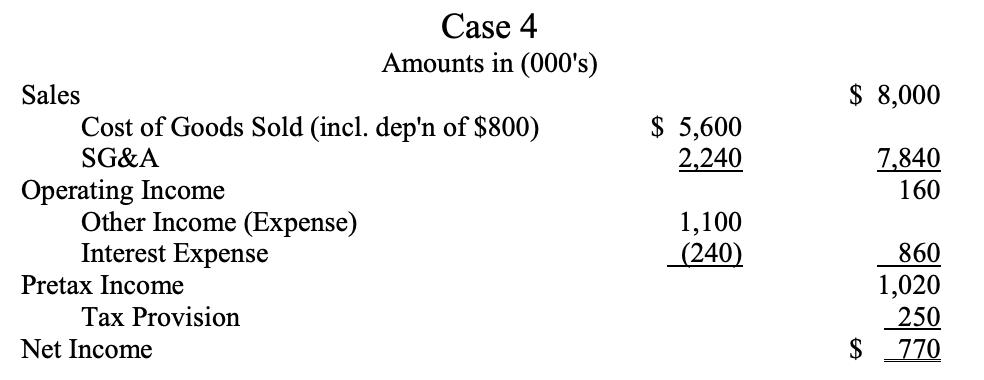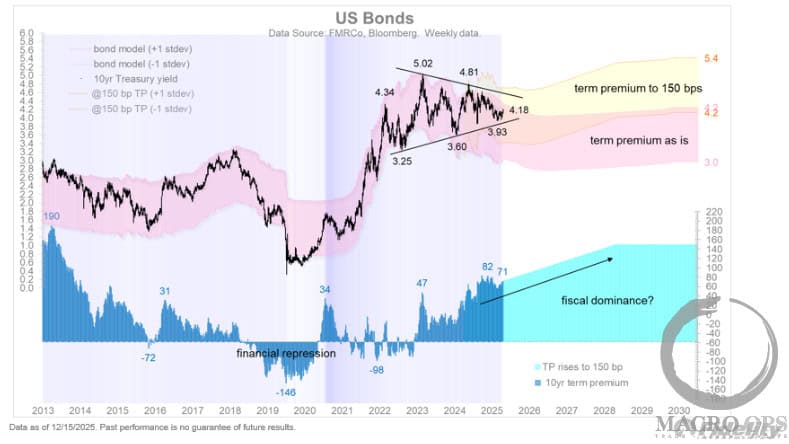Warning, this piece gets into the weeds of financial accounting statements. We dive deep into the cash flow statement, why it matters, and equip you with the knowledge to dissect statements on your own.
Before diving into the meat, one should understand why the cash flow statement is so important. There’s a few reasons:
-
- Cash tells you the true earnings power of the business
- You can’t pay debtors and creditors with EBITDA — you pay them with cash
- Cash flow statements show you where a company generates cash and how it spends it over the course of a year or quarter
We’re using Cash Flow Analysis: Modified UCA Cash Flow Format to analyze the cash flow statement. I encourage you to download the PDF and follow along as you read this essay.
It’s What You Do With Cash That Matters
We study the cash flow statement because there are only a few ways companies can spend cash.
They can either buyback stock, issue dividends, acquire a business, reinvest in their own business or pay down debt. That’s about it.
Knowing how each of these decisions impacts a company’s cash balance is a crucial step in becoming a better investment analyst.
Let’s dive into the set-up for our cash flow analysis.
The Set-Up
The paper gives five case studies for analyzing cash flow statements. What’s interesting is that cases 1-4 report identical net income. How they get there is anything but identical.
We finish with a fifth example showing a net income loss. Through this fifth example we’ll see the power of focusing on the cash flow statement. It’s at this moment we see the detriment of obsessing over the P&L statement.
The First Four Cases
Our first four cases (or companies) generated $8M in revenue and $770K in net income. Those are the constants.
Let’s take a look at the first three cases’ income statement data:
C1-3 generated $1.12M in operating income and $1.02M in pre-tax income. Subtract out tax and we get our $770K net income figure.
Here’s where things get interesting. Though C4’s revenues are equal to C1-3 ($8M), C4’s operating income is almost $1M lower. How is this possible?
Take a look at C4’s income statement data:
There’s one line item that accounts for the discrepancy. C1-3 generated $140K from “Other Income” while C4 generated $1.1M. In fact, C4’s “Other Income” is enough to bring it in line with C1-3’s pre-tax income of $1.02M. That’s quite the difference.
The Power of Working Up The Income Statement
This is where we see our first large dichotomy on the income statement: Interest Expense & Other Income
Case 4 shows $770K in net income largely due to the $1.1M in “Other Income”. This is important. If you don’t actively analyze the income statement, you’d easily miss this.
If we “normalize” the “Other Income” for both companies, Case 4 would report substantially lower net income. In fact, if we normalize C4’s “Other Income” with C1-3, they’d report negative net income.
Now why does this matter? It matters because not all income is created equal. C1-3 are much stronger businesses because they generate the majority of their pre-tax income through their operations. You can’t say the same for C4.
In other words, you can’t rely on $1.1M in “Other Income” each year to make your bottom line. That figure could flip negative in an instant. Operating income on the other hand is much harder to sway. At least in that short of time frame.
That’s the 30,000ft view. Let’s dive into each specific case and look at their cash flow statements. What are they telling us that we can’t find on the income statement?
Company 1: Cash Flow vs. Income Statement Analysis
The first thing to focus on when moving from income statement to cash flow is accounts receivables. Specifically, you want to measure the change in those receivables.
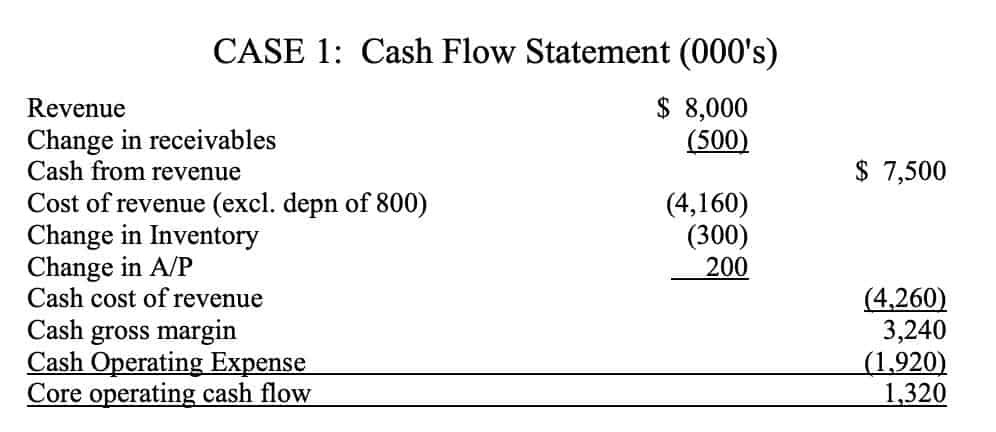 In C1, we see -$500K in change in receivables. This means C1 sold more products on credit than they collected from customers that owed them money. In short, they received less cash in the bank from the product/service sold.
In C1, we see -$500K in change in receivables. This means C1 sold more products on credit than they collected from customers that owed them money. In short, they received less cash in the bank from the product/service sold.
We adjust the change in receivables and recognize $7.5M in revenue. This is slightly lower than what’s reported on the income statement.
We see further differences in cost of goods sold (COGS). On the cash flow statement we see total COGS of $4.26M. This is lower than the income statement’s $4.96M.
The difference lies in an exclusion of an $800K deposit, as well as $300K increase in inventory reduced against $200K in paid accounts payable. This gives us $3.24M in gross profit (or 40.5% gross margins).
Operating expenses stay the same between the two statements at $1.92M.
Here’s the final core operating cash flow picture:
-
- Income Statement: $1.12M
- Cash Flow Statement: $1.32M
We’re going to use that $1.32M number on the cash flow statement to get true free cash flow.
After arriving at our core operating cash flow, we need to find how much cash to outlay for taxes. The cash flow statement shows $18K in recurring cash payments, plus $250K tax provisions.
 We add $40K for deferred tax liability and -$42K for income taxes payable. This nets out to $252K needed for taxes. Those two figures ($18K and $252K) reduce our cash available (I.e., free cash flow) by $270K. This leaves us with $1.05M to service debt.
We add $40K for deferred tax liability and -$42K for income taxes payable. This nets out to $252K needed for taxes. Those two figures ($18K and $252K) reduce our cash available (I.e., free cash flow) by $270K. This leaves us with $1.05M to service debt.
C1’s interest expense is $240K, which doesn’t deviate from income statement or cash flow statement. Now we’re left with $810K.
But we’re not done. We still need to account for capital expenditures. These can be for growth, maintenance, or a combination of the two. Regardless, we must pay them with cash.
Important Note: You won’t find capital expenditures in the income statement. You will only find that on the cash flow statement or balance sheet (potentially).
We see C1 spent $1M on CapEx in the current year. This brings our true FCF to -$190K.
The ending difference between what the income statement shows in net income vs. what the cash flow statement revealed as FCF:
-
- Income Statement Net Income: $770K
- Cash Flow Statement Free Cash Flow: -$190K
- Total Difference: $960K
Onto Company 2!
Company 2: Same Income Statement, Different Cash Flow Statement
Remember, with C1-3 we have Identical Income statements. It’s the cash flows that differ.
C2 recognized $8M in revenue, but received $1.8M less in cash from that revenue. In other words, they sold $1.8M more product on credit than they collected from their customers. This could signal further problems with the business.
Questions to consider when faced with rising accounts receivables:
-
- Why aren’t their customers paying?
- Why are they selling more on credit?
- Will they get those receivables back?
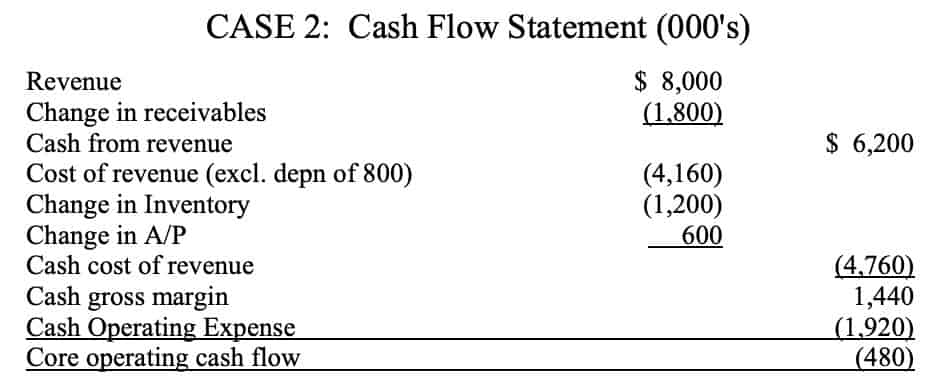 This gives us $6.2M in cash from revenues. Already off to a sketchy start.
This gives us $6.2M in cash from revenues. Already off to a sketchy start.
It gets worse for C2. The company spent $4.76M in cost of revenue. C2 spent $1.2M on increasing inventory and saved $600K in accounts payable (I.e., not paying accounts payable for the period). They’ll eventually have to pay that $600K. So although it’s a positive adjustment to the current cash flow figure, we’ll need to reduce it by $600K at some point in time.
Adjusting for cost in revenues and changes in inventory/accounts payable gets us $1.44M in gross profit (18% margins).
You can see the effects these negative changes have on gross margins. Remember, Cases 1 & 2 have identical income statements, but C2 has 22% lower real gross margins.
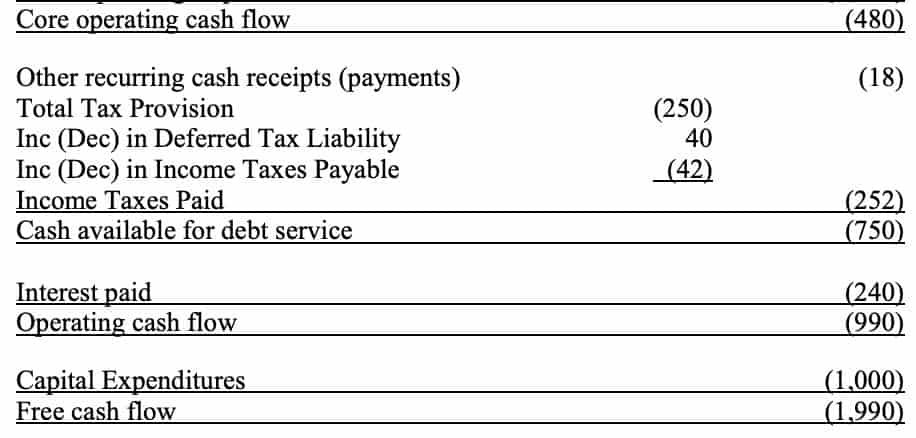 From our gross margin we subtract operating expenses of $1.92M. This gives us core operating cash flow of -$480K. This is a much different picture than the income statement’s $1.02M pre-tax operating income.
From our gross margin we subtract operating expenses of $1.92M. This gives us core operating cash flow of -$480K. This is a much different picture than the income statement’s $1.02M pre-tax operating income.
Moving down the cash flow statement we see C2 with identical tax and liability payments ($252K). This brings cash available for debt service to -$750K. Bondholders won’t be happy about that.
Subtract another $240K in interest payments, another $1M in Capex and we get true free cash flow of -$1.99M. Ouch!
The ending difference between what the income statement shows in net income vs. what the cash flow statement revealed as FCF:
-
- Income Statement: $770K in net income
- Cash Flow Statement: -$1.99M in free cash flow
- Total Difference: $2.76M
Not all hope is lost. Our third company proves a bit more promising for our bondholing friends.
Company 3: A Less Worse Picture of FCF
C3 looks better than both C1 and C2. The company generated $8M in revenue with a -$500K adjustment in receivables. This means C3 collected $7.5M in cash from those revenues.
C3 spent $4.26M to generate that revenue. $300K was spent on increased inventory, and $200K was saved by not paying accounts payable.
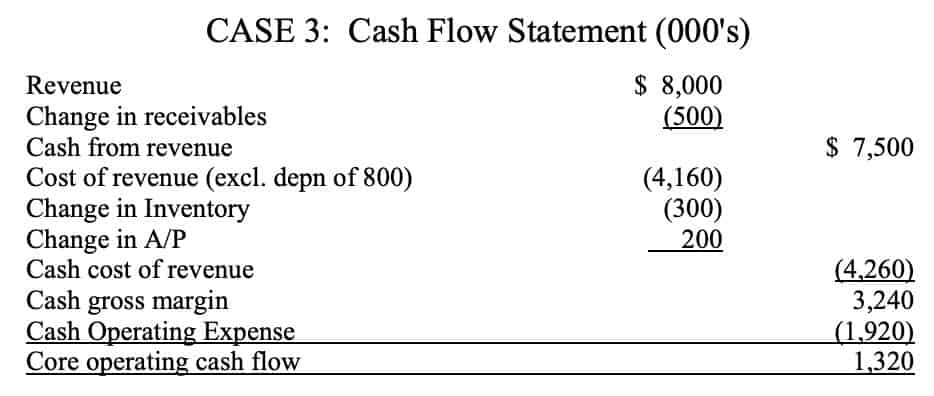 This gives us $3.24M in cash gross profit (40.5% margin).
This gives us $3.24M in cash gross profit (40.5% margin).
Reducing our gross profit by $1.92M in operating expenses gets us $1.32M in core operating cash flow. This is $200K more than what’s stated on the income statement.
So far so good, right? Let’s move to the tax provisions and tax liabilities section.
C3 allotted identical amounts for tax provision, $250K. But this is where things get tricky.
C3 marked a $950K decrease In deferred tax liability. Confused as to what that means, check out the definition of deferred tax liability (according to Investopedia):
Deferred tax liability is a tax that is assessed or is due for the current period but has not yet been paid. The deferral comes from the difference in timing between when the tax is accrued and when the tax is paid.
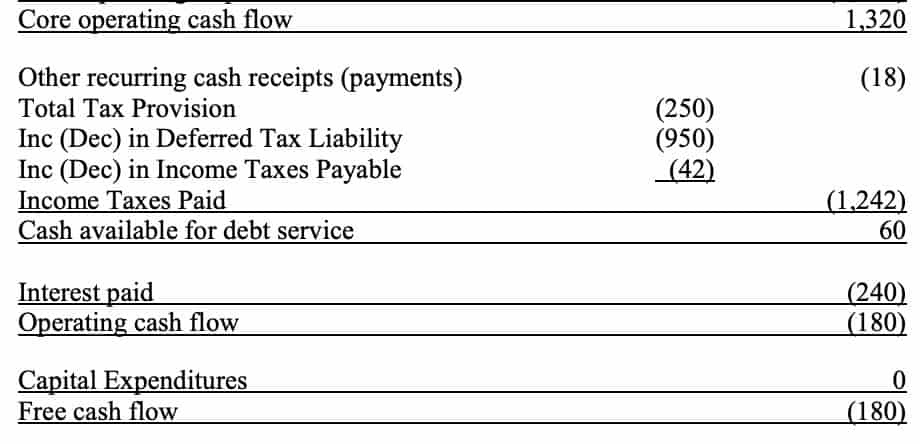 The decrease means Company 3 paid more in taxes this year to make up for past taxes they didn’t pay. This is why you see C3’s total “Income Taxes Paid” at $1.242M.
The decrease means Company 3 paid more in taxes this year to make up for past taxes they didn’t pay. This is why you see C3’s total “Income Taxes Paid” at $1.242M.
After that massive tax bill, the company has a mere $60K to pay its debtors. Shave off another $240K in interest payments and we’re left with -$180K in operating cash flow.
Finally, the company didn’t spend any money on Capex in the current year. Maybe they didn’t spend anything for growth or maintenance. Regardless, C3 reported -$180K in true free cash flow.
The ending difference between what the income statement shows in net income vs. what the cash flow statement revealed as FCF:
-
- Income Statement: $770K Net Income
- Cash Flow Statement: -$180K Free Cash Flow
- Total Difference: -$950K
Alright, at this point you’re probably wondering if we ever get to a company that shows positive free cash flow. Yes. Company 4 is our cash-flow knight in shining armour.
Company 4: What Positive Free Cash Flow Looks Like
We finally see positive free cash flow from C4’s cash flow statement. You know what we have to do. Break it down.
C4 generated $8M in revenues and $7.5M after adjusting changes in receivables.
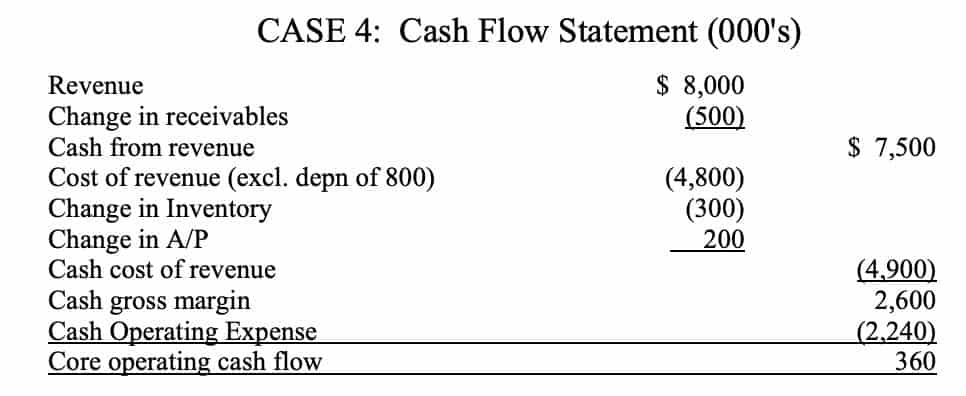 C4’s cash cost of revenue came in at $4.9M. This breaks down to $4.8M from cost of revenues, minus $100 net change in inventory and accounts payable.
C4’s cash cost of revenue came in at $4.9M. This breaks down to $4.8M from cost of revenues, minus $100 net change in inventory and accounts payable.
This gives us $2.6M in gross profit (32.5% gross margins).
From here we deduct our cash operating expense of $2.24M to get $360K in core operating cash flow.
As you might’ve noticed — this is substantially lower than C1 and C3. You’re wondering, “but Brandon, how in the heck can C4 get to positive free cash flow with all those interest and tax payments further down the statement? The answer: Other.
Company 4 received $942K in Other Recurring Cash Receipts. On top of that, they paid $252K in income taxes.
This means they have $1.05M in cash available for debt service.
Notice how large a benefit the recurring cash receipts were to the company’s free cash flow.
Are those receipts truly recurring? If not, we should assume this is a one-time benefit and forecast accordingly.
Now all that’s left is to subtract interest and capex to get our free cash flow.
Company 4 paid $240K in interest and spent $0 on Capital Expenditures. This gave them $810K in true free cash flow.
The ending difference between what the income statement shows in net income vs. what the cash flow statement revealed as FCF:
-
- Income Statement: $770K Net Income
- Cash Flow Statement: $810K Free Cash Flow
- Total Difference: +$40K
Company 5: One Last Example w/ Different Income Statement
Company 5 has a different income statement than C1-4. Let’s flesh it out before going to the cash flow statement.
 C5 generated $8M in sales. COGS totaled $5.6M and SG&A totaled $2.24M. This gave C5 $160K in operating income.
C5 generated $8M in sales. COGS totaled $5.6M and SG&A totaled $2.24M. This gave C5 $160K in operating income.
After subtracting $240K in interest expense, C5’s left with -$80K in pre-tax income. Add back $20K in tax benefits and you get -$60K in net loss.
Okay, now on to the cash flow statement.
C5 generated $8M in top-line revenue, but also recorded a $500K increase in cash received from receivables. This means the company reduced its accounts receivables (on the balance sheet) — collecting more cash from its customers than the previous period.
This gives us $8.5M in total cash received from revenues.
From that, we subtract $4.7M in cash cost of revenues. This includes $4.8M in COGS, a $300K positive adjustment for reduction of inventory and a $200K charge for accounts payable.
We’re then left with $3.8M in gross profit (47.5% gross margin).
Then we subtract our cash operating expenses ($2.24M) to get $1.56M in core operating cash flow.
So far, C5 has generated more core operating cash flow than C1-4. Let’s move down the statement for taxes and capex.
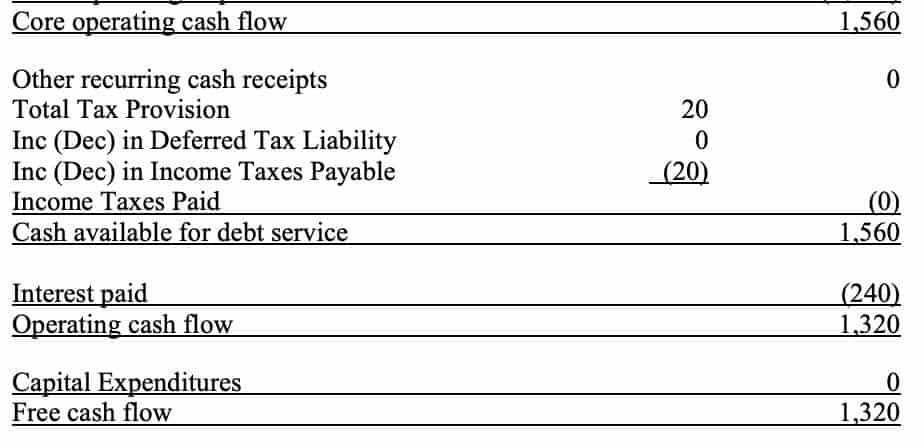 C5 paid $0 in income tax. How is this possible? The company had $20K in tax provisions offset by a $20K decrease in income taxes payable.
C5 paid $0 in income tax. How is this possible? The company had $20K in tax provisions offset by a $20K decrease in income taxes payable.
This left them with $1.56M in cash available for debtors.
After subtracting $240K in interest we’re left with $1.32M in operating cash flow.
C5 also elected not to spend any cash on capital expenditures, leaving all $1.32M for true free cash flow.
Operating Cushions, Working Capital and Core Growth Profile
As investors, we should focus more on the cash flow statement and less on the income statement. By going through each case study, we saw the differences a cash flow approach can make on analyzing a business’ true cash-generating capabilities. Each company generated the same amount of net income, but the amount of cash generated varied widely — and we could only pick that up by looking at the cash flow statement.
Our goal is to find companies that can grow the amount of cash they generate over time, and then to buy that company at a discount to those estimated cash flows.
But how can we estimate if a growing business is actually good for a company’s cash flows? After all, growth isn’t created equal. Growth can reduce cash flow in some companies, while juicing it in others.
That’s where Operating Cushion comes in. Simply put, Operating Cushion is the % difference between your gross margin % and your SG&A %. In English, it’s the contribution of a $1 increase in revenues to operating profits.
Using the paper’s hypothetical company, we see a gross margin of 39.56% and SG&A of 30%. This gives us 9.56% in operating cushion.
So, a $1 increase in this company’s revenues generates $0.096 in operating income.
The higher the better.
The paper takes it one step further, calculating a company’s Core Operating Growth Profile.
This is simply your Operating Cushion plus Working Capital %.
Here’s how we get Working Capital %:
-
- Subtract A/R to revenue %
- Subtract Inventory to revenue %
- Add A/P to revenue %
In the example from the paper, this gets us -36.48% in working capital and -26.92% in Core Operating Growth Profile.
So, for every $1 increase in revenue, the company will burn $0.26 in operating cash flow.
You can see how powerful Operating Cushion and Core Operating Growth Profile is to an investor’s toolkit.
Closing Thoughts
The cash flow statement is the most important financial statement in a company’s books. It shows us how much cash a business generates, where management spends the cash, and how much they actually receive on their revenues.
It shows us a company’s cash-generating power, not its financial engineering pedigree.
By focusing on the cash flow statement, we’re also able to determine if growth is value creative or destructive.
If this white-paper has taught me anything, it’s that cash flow is king. Focusing on cash flow (not the income statement) will make you a better investor.


